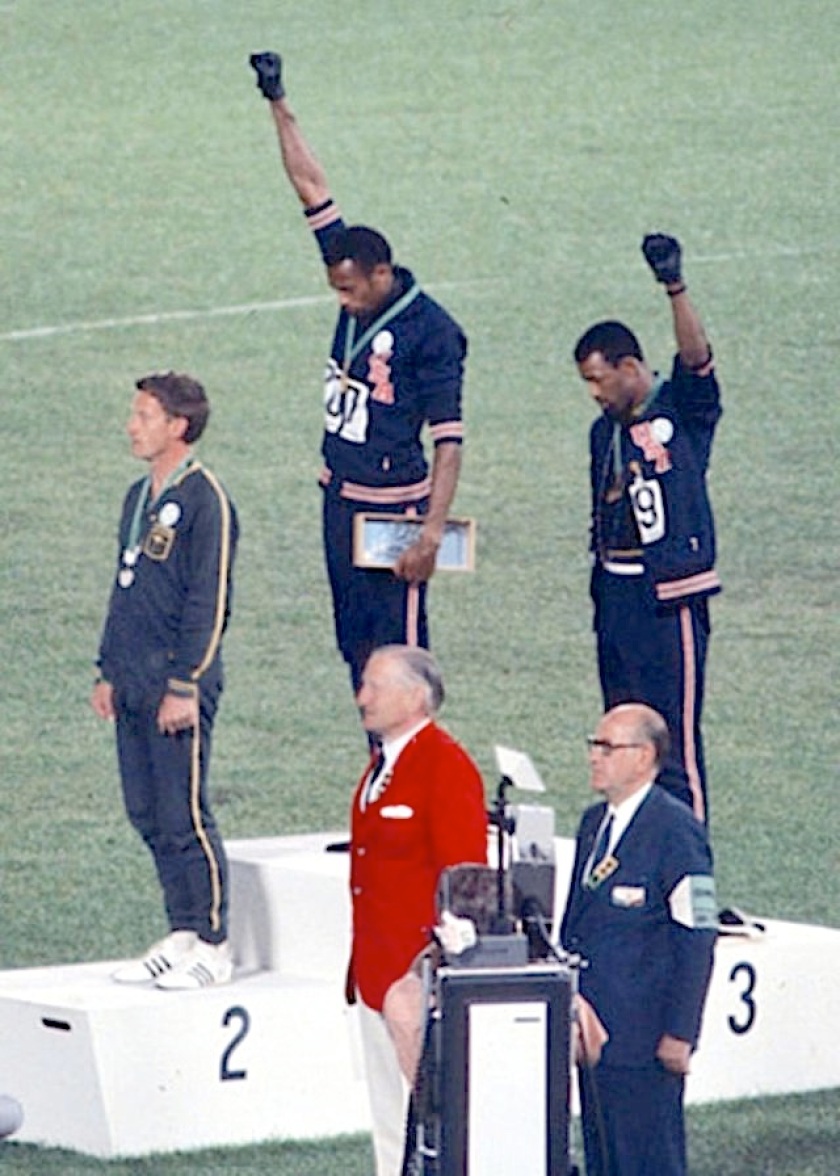
One sporting event that had a big impact on me and people of my generation was the Black Power salute by Tommie Smith and John Carlos at the 1968 Mexico Olympics. They were supported by Australian sprinter, Peter Norman. It was this protest that I think influenced me to participate in the strike against apartheid at the University Queensland during the 1971 Springbok tour of Queensland.
White glove
The 1968 Olympic Games began just 10 days after the Mexican army massacred over 300 students in the Plaza de las Tres Culturas in the Tlatelolco section of Mexico City. The International Olympic Committee refused to postpone the games claiming that there was no room for politics in sport.
The massacre was provoked by the Olympia Battalion, a secret government branch made for the security of the Olympic Games composed of soldiers, police officers, and federal security agents. The Olympia Battalion members wore white gloves or white handkerchiefs tied to their left hands to distinguish themselves from the civilians and prevent the soldiers from shooting them (from Wikipedia)
Black glove
A couple of weeks later, Tommie Smith set a world record of 19.83 secs for the 200 metres and Peter Norman, running second, set an Australian record of 20 seconds which still stands today, 50 years later.
I think Peter Norman produced one of the best ‘kicks’ of all time in the 200 metre sprint; on the turn he was running in about fifth place. John Carlos and Tommie Smith had opened up a big lead on the field and were fighting it out for first place, yet Peter Norman ran down John Carlos and may have caught Tommie Smith if he were faster out of the blocks. It was the last Olympic race for all three athletes, who, together with other finalists, comprised the greatest group of sprinters ever assembled.
A few days before another African-American athlete, Bob Beamon, jumped an astonishing 8.9m (nearly 30 feet) in the long jump breaking the previous world record by 55 cm (nearly 2 feet). This was his first jump in the final and he collapsed straight after. One of his fellow competitors, the defending Olympic champion Lynn Davies, told Beamon, “You have destroyed this event.” His jump remains the Olympic record and has only been beaten by one other in history.
Meanwhile, in the high jump, American Dick Fosby jumped 2.2 m with his famous ‘fosby flop’. This was an Olympics of great sporting achievement for athletes competing at high altitude. However it showed the ugly and racist nature of both the US and Australia. Bob Beamon nearly didn’t make it to the Olympics because he was suspended from the University of Texas at El Paso, for refusing to compete against Brigham Young University, because it had racist policies. This left him without a coach. He nearly didn’t even make the final because he fouled on all but one of his jumps in the qualifying.
During the medal presentations for the 200m San Jose State teammates John Carlos and Tommie Smith took the podium with black-gloved fists raised in the air and their shoes in their hands. Their bare feet, a symbol of poverty; their clenched hands and bowed heads were an appeal for equality. In his autobiography, Silent Gesture, Tommie Smith, the son of a Californian farm labourer, stated that the gesture was not a “Black Power” salute, but a “human rights salute”.
Tommie Smith and John Carlos were sent home in disgrace and Peter Norman was outlawed in Australian athletics. All three were booed on the victory dais by a section of the crowd and their families received deaths threats at home.
Earlier in 1968, President Lyndon Baynes Johnson (LBJ) announced that he would not contest the presidency because so many GIs were being killed in Vietnam.
In Australia, Prime Minister Harold Holt had gone all the way with LBJ sending more conscripts (nashos) to a genocidal war against communism in Indochina. At the same time both Martin Luther King Jr. and Bobby Kennedy were assassinated. All three: King, Kennedy and Johnson, had championed civil rights for black Americans. Yet incoming President Nixon escalated the war in Vietnam and persecuted black Americans in the South.
Strange Fruit
Even though more individual in nature, the Black Power salute by Smith and Carlos in Mexico in 1968 has a modern equivalent. Fifty years later, presidential-sponsored-racism results in African-Americans being shot down in the street by police giving rise to black-lives-matter protests. 21st century shootings have replaced 20th century lynchings.
Hopefully kneeling protests by African-American footballers will spark a new era for change and social equality.
IanCurr
29 Sept 2017
PS To this day the Australian Olympic Committee (AOC) does not accept that Peter Norman deserves an apology for their refusal to send him to the 1972 Munich Olympics and failure to invite him to the Sydney Olympics in 2000.

Photo: Democratic rights protest in Mexico City 1968
References

One thought on “Silent protest in Mexico ’68”